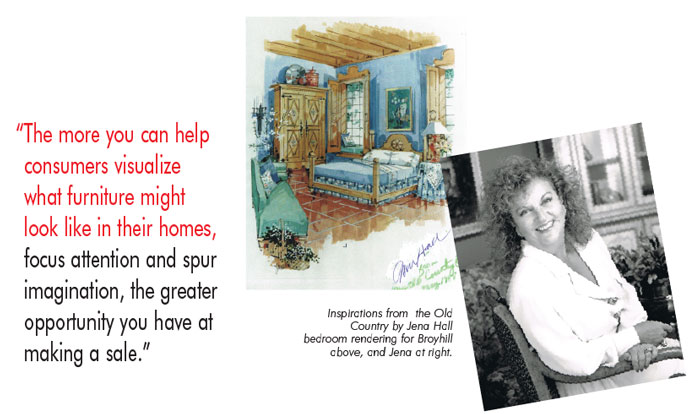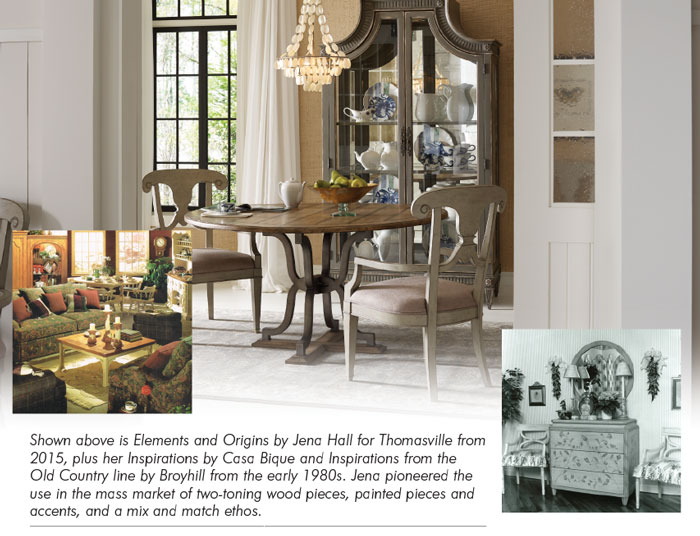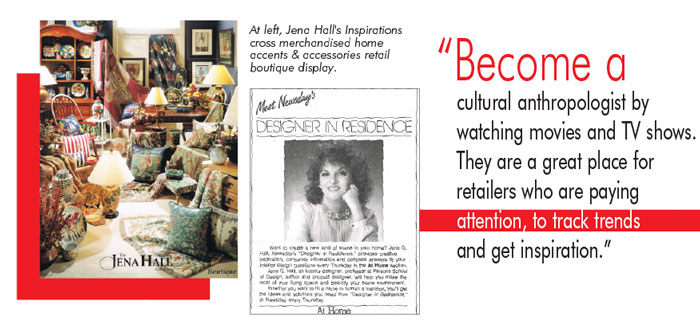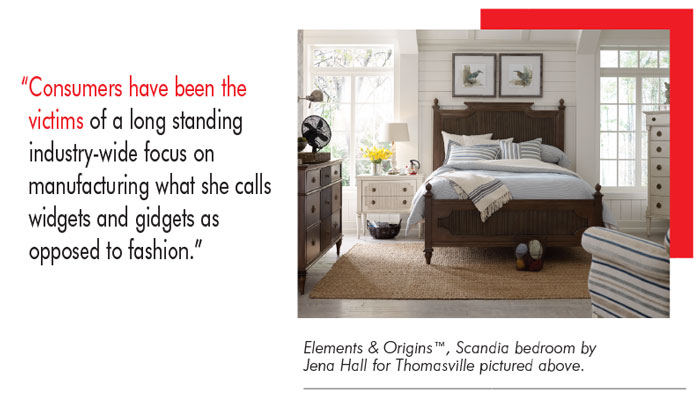
Legendary designer and Hall of Famer talks about home furnishings design, plus how retailers might approach visual merchandising and store display to combat the sameness and boring at retail.
In this edition of Furniture World Magazine’s “Design and Designer“ series we interview iconic designer Jena Hall. Jena was the first interior designer to successfully launch her own label and license it to over 22 home furnishing companies. The result was a huge body of work, over 35,000 sku’s, from furniture to fabrics, lighting, rugs, sheets, shower curtains, table top, bathrooms, kitchens and much more.
Over a span of 30 plus years, her company, Jena Hall Designs evolved into a design and consulting company developing private label and other licensed and cross-merchandised concepts for some of the top furniture and related companies including: American Drew, American Leather, Andersen Windows, Bassett, Broyhill, Casa Bisque, Casa Stradivari, Century, Domain , Ethan Allan, Henredon, Hulster of Germany, Johnston Casual, Lyon-Shaw, Maitland Smith, Nichols & Stone, Profiles, Pennsylvania House , Sarreid, Wynnwood, Valdese Weavers, Vanguard Furniture, Carolina Mirror, Revman Sheets, Wildcat Territories Top of Bed, Riverdale Pillows, TransOcean Rugs, Elger Plumbing, Andersen Windows, Lenox China, Oriental Accents Lamps and decorative accents, HGTV HOME Brand, Aspenhome retail environments, Robb & Stucky, Horchow, JC Penney, Spiegel’s, Ethan Allan , Sears, and Brueners.
She was also a home furnishings columnist for New York Newsday, syndicated in over 450 newspapers.
Beyond her design work, she set herself apart as a role model through charitable efforts. She is the founding President of WithIt (Women in the Home Industries Today), past Chairman, and a member of its Board of Governors; served as National Co-Chair and serves on the National Executive Committee of City of Hope’s Home Furnishing Industry Division, participated on its National Board, plus was active on the ADL’s National Board.
Home Furnishings Division’s Executive Committee. She was inducted into the American Furniture Hall of Fame in 2014.
Evolution Of Furniture Design
Asked how furniture design has evolved during her tenure designing furniture, Jena observes, “Back in the early 80s, “very few better goods were being shown at High Point, then known as the Southern Furniture Market. At that time a handful of suppliers created and/or imported off the shelf products, bringing in original designs I had designed for high-end European factories, some times custom finished in America .
These suppliers catered To The Trade or the so-called custom market, and were primarily sold through designer showrooms such the D&D building in New York , the Dallas Mart, LA Mart, and of course later, Chicago, Atlanta and the Miami Design Center. That was the beginning of the higher-end market blending with the more commercial brown boxes.”
At that time Jena designed for Casa Bique, and Gample Stoll high-end lacquered furniture in the New York area as well as Werner Myer, a company that primarily, brought in antique reproductions from Spain and Italy. “Some of these showrooms,” she recalls, “imitated the Italian lacquer popular at the time, and these were the first to open up showrooms in High Point on North Hamilton Street, attracting fashion merchandisers from better department stores that had decent furniture departments. It’s hard to believe, but it wasn’t that long ago, that companies like Marshall Field’s in Chicago, Bloomingdale’s in New York, Altman’s and other department stores carried really beautiful furniture, an assortment of off the shelf designs from Europe alongside trade showrooms. And since I had my own interior design business, and understood the market, that’s where I got my start designing products for retailers and high-end importers.

Chance Meeting at imm cologne
“In the early 80s, while attending the Cologne fair,” Says Hall, “I shared a cab with Bill DiPaolo, Vice President of the Southern Furniture Market Center. He asked me why I didn’t go to High Point instead of Germany to buy goods. I replied that I had been to High Point but there was nothing there for me.”
Jena went on to explain that as a result of that chance meeting, she introduced DiPaulo to some vendors, and that was the beginning of design oriented European participation at the International Market Center. “That’s when the market really started to change,” she added.
Birth of Mass Market Furniture Designer Lines
“I had designed a European Antique inspired painted group for Casa Bique called European Country InspirationsTM by Jena Hall. Broyhill in the meantime, like a lot of typical North Carolina factories, was still producing basic, brown case goods.”
Jena was approached by Broyhill to create a group based on Scandinavian Country furniture design, similar to what she did for Casa Bique. “I wasn’t sure it was a good fit since I had been designing high-end, hand painted, To The Trade furniture,” she explained.
By that time, she had noticed the growth of licensing in apparel. “The apparel industry,” Jena observed, “used to have brands for men like Robert Hall suits and ladies’ Ship ‘n Shore blouses. These were just manufacturers’ brand names. But in the late ‘60s, little by little, the old apparel brands took on designer names. Ralph Lauren who was a menswear designer designed branded sheets for department stores. Gloria Vanderbilt created a line as well. Before that, sheets were either white, ecru, pink or mint. There were no plaids and no florals, and there was no licensing at all except for Pierre Cardin & Dongia, both too early and too expensive for retail furniture.
“The apparel people put their name on one type of product, and then another product, and another. And it all went together. Wow, I thought, that’s how I design interiors. I realized that it could be done for a mass-market home furnishings line. No one was designing a cross merchandised collection. ”
She was writing a syndicated column at that time for about 450 newspapers, a full page in Newsday every week with a Q and A, taking questions from all over the country. “Consumers would ask me questions such as, ‘I’m re-doing my room, and I don’t know how to put it together. What would go with my avocado sofa? And what would go with my pink rug?’
There was a need at the retail level for a home furnishings line that could mix or match like a ready-to-wear line to help people put things together themselves… a decorator look at affordable retail price points. Products would be pre-designed by a number of manufacturers under a license with a designer.”
That was the start of her licensing division. She started working with Broyhill, then added 21 additional licenses over the next ten years.
“Before that, everything in retail furniture stores was lined up, as Broyhill’s President Gene Gunther used to say, like brown boxes.”
Jena’s idea was somewhat radical at a time when mid-range furniture was designed in matching sets without accent pieces, painted finishes, or variation in finish, color or texture.

“We didn’t call them accents then. The Broyhill line was called ‘Inspirations from the Old Country’. It included, for example, an accent piece, an armoire, that went with one other accent piece and complimented the upholstery and a wood element in the broader collection. Another thing we did in Broyhill’s Inspiration line, which really changed the industry, was the creation of a casual great room that included an informal entertainment cabinet inspired by a captain’s table and chair I found in an Andrew Wyeth painting.”
The Inspirations from the Old Country line included as well, a two- toned table and chairs. Consumers could still use an all-wood buffet, or an all-white hutch. “So, as time passed, she noted, they could keep some of their old furniture, but freshen up the look by adding new pieces. For example, an accent painted armoire in pastel colors or two tone wood as a bridge.”
Jena noted that when she first showed her sketches to Broyhill, they objected to combining two finishes on one item due to manufacturing concerns. She explained that these pieces acted as a bridge, “a term that came out of the apparel industry. Apparel lines used to have what they called bridge lines that would help consumers transition from winter to summer with the spring line in between. It also helped companies get higher price point bridging from entry to higher end goods.
“Two toning pieces is an industry standard today as are colored painted accents. The Elements and Origins line I recently designed for Thomasville included painted and two tone bedroom pieces that give customers the choice of buying a black bed or a wood bed and one nightstand with a black wood top and stained brown case, a painted crabby apple red end table, or a hunter green end table that marries to the upholstery fabrics, the area rugs, top of the bed and everything else designed to go in that room.”
Jena went on to explain that the importance of the Broyhill line for retailers was that they could offer for the first time ever, a decorator at an affordable retail price point. “After that”, she noted, “Timberlake came out, Gloria Vanderbilt, Bob Mackey, followed by all sorts of designer du jour licensed lines identified with celebrities, movie stars and museums. And today in the furniture industry, the practice of licensing is a huge part of the market.”
More recently, Jena has moved on to work on private label projects and develop creative strategies for manufacturers.

Good Design Today
When asked what makes good furniture design in today’s market, she observed, “First of all, the timing has to be right, the quality has to be right, and the level of innovation has to not be too far ahead of the curve and not too far behind. The fact that a group is licensed or not has little to do with how well it will sell. That’s just marketing icing on the cake.” And what should retailers be looking for? Jena, who also has deep experience with retail merchandising and store design recommends, “Retailers should be looking to purchase designs that are familiar enough, yet still fresh.” Her prescription is that when retro designs such as Mid-Century Modern, Country French or Scandinavian Country are brought back out, they need to have to have a new twist, fresh finishes, be differently scaled or include innovations in function, so retailers don’t end up putting dated looking brown box furniture in front of customers.”
She says that the industry has come a long way in the last 30 years, but asks, “how many changes can you make to a dresser and still have it be a dresser? The plain case has given way to multiple sizes and drawer configurations. It has to have drawers, a top, legs and feet. Traditional styled feet can be changed to modern. Now what?”
“Now what” is what retailers should be asking,” she insists. “That ‘now what’ is the most important question to ask when merchandising a line.”
Price
Jena elaborates. “We all know that much of the furniture out there today has a ‘me too’ mentality driven by price competition instead of innovation and fashion, better value and functionality. Great merchants today have to be much sharper in carrying good, better and best price points. And how do they get to best? They have to offer customers more in size, scale, features and styling. Most better merchants who survived the recession know how to do this, but it doesn’t change the fact that consumers have an abundance of choices today. Some retailers seem to forget,” she observes, “the last thing consumers consider is price. They have to like it first. It has to serve their needs second. And then, they consider how much it costs. Only if they find the same thing in three stores, are they going to shop for the best price.”
Design Trends
As consumers have become more mobile, tastes in furniture have become less regional. Jena explains, “while you can’t sell white finishes in certain parts of the country or dark finishes in others, especially younger consumers are looking for products that suit their individual taste and preference to mix and mingle instead of match. My Elements and Origins collection for Thomasville used the term American NouveauTM instead of eclectic to describe this current trend.”
Is there still work to be done at retail to both update displays to reflect this change and get consumers excited about new possibilities in home furnishings?

“Old habits die hard,” she says, noting that in some sense consumers have been the victims of a long standing industry-wide focus on manufacturing what she calls widgets and gidgets as opposed to fashion.
“If you pay attention to home furnishings used in old Turner Classic movies, vintage movies, you will notice that those stage sets were gorgeous, and nothing matched. The same has always been true with high-end and antique furnishings. Nothing matched at the Palace of Versailles!
“This was not the case with our mass-produced furniture. Manufacturers made cuttings and retailers bought what they made. Consumers were sold brands marketed as quality heirlooms that would last forever. They said, ‘here’s your matched beautiful cherry, 18th century dining room.’ The average consumer didn’t know the difference and had few options. Consumers were mostly interested in buying functional furniture that they could brag to their friends that they spent ‘X’ amount of dollars buying ‘X’ brand.”
Jena also notes, “selling matched sets made life easy for average sales associates who just wanted to get an up, make a sale, close the deal, and move on to the next up.”
“That generation of customers and retailers are dying out,” she continues, “or have changed their preferences.
“On the manufacturing side, most are importing, so they don’t have huge cuttings but they still have to consider if they can sell another 50 or 100 pieces of an item before they reorder. They are generally reluctant to do too much mix and mingle, too many different finish choices or accents, because they don’t know how retailers are going to buy a group. Therefore, the majority are still offering mostly matched brown boxes.
“That’s wrong thinking,” she adds, because “to do it right, manufacturers need to have courage and conviction about their designs, and encourage retailers to display it beautifully in showrooms and lifestyle photography so they have a better shot at giving their customers more exciting interiors than just a matched set.”
But that isn’t enough she tells us. Retailers, in general need to get better at helping customers, using interior designers or, depending on the retailer, qualified sales associates, to at least pick out an accent piece or two and mix it up to create excitement.
“Younger consumers who are coming out of a West Elm or Pottery Barn experience don’t want their furnishings to match. They just want to like what they buy. I think we’re going to see Millennials start to evolve as they get jobs, move out, up and get married. They are mobile, just now getting jobs and settling in. This group already has experience decorating online, has access to a huge amount of decorating self-help information, and helpful apps. They like change, instant gratification and easily get bored. These are factors that retailers who want to be successful should consider and address. I suggest an ‘ever changing what’s new’ display every few weeks and promote it, They love new.”
Finally, Furniture World asked Jena to talk about where she sees the market going in terms of design.
“Right now, we’re in a 20th century, retro period,” she tells us, “with a focus on Scandinavian Modern. We are seeing Teak, and Walnut in dry- hand finishes. Also,’50s white and lacquered painted pieces are back. While mid-century seemed to be just a blip on the screen a couple years ago, it’s hotter than ever right now even in upholstery where if it’s not up on exposed legs, it’s not selling.

“I think we’re going to stay in this retro mood for a while which has, in part, been brought to the attention of everyday consumers by retailers such as Design Within Reach, Pottery Barn and Crate and Barrel.
“There are still plenty of decades in the 20th century to explore and be inspired by. Just when you think something is really, really, really dead, it starts to creep back in again slowly! It never comes back in its pure form.” An example of this is the introduction by Thomasville Jena recently designed. “We brought the traditional Scandinavian back this time for Elements by Thomasville. This collection has a cleaner, relaxed look and modern feel even though it was inspired by pieces popularized during King Gustav III’s time in the 1800s.”
For the future? “I think we are going to start seeing traditional Asian design fused with Chinese modern and 50’s modern. Maybe even Mediterranean again, but rethought of course, with a new bleached look, think Havana in the 1950s,” she says.
“Another important trend on the horizon is truly multi-functional furniture, meaning furniture with changeable components that can be moved around internally. Pieces like these can go in a bedroom, dining room or even a living room. People are very mobile today, Baby Boomers are downsizing, Millennials are upsizing. Pieces have to find new functions when they move, especially when spaces don’t permit everything to fit. I did a great Collection for Somerton Dwelling- totally modular and flexible called Improv. It started out slowly but now it’s really moving very well to interior designers and Millennials, go figure. Furniture must serve dual functions. Building in functionality is essential for success today. This fact is always on my mind because furniture that does something, has an extra bell or whistle, has higher perceived value. We’ve heard about smart furniture which is normally associated with electronics, but there’s a huge future in exploring furniture that provides innovative storage, is stackable or stretchable.”
Cultural Anthropology
When asked what, in general, are the most important areas for improvement for home furnishings retailers, Jena suggests, “Most retailers need to work on their visual merchandising. A surprising and easy way to do this is to become a cultural anthropologist by watching movies and TV shows. They are a great place for retailers who are paying attention, to track trends and get inspiration. This kind of focus can make a major difference for how retailers present furniture, helping them to make it interesting using color, fabrics, lighting and accessories. The time has past when retailers could get away with just putting any old lamp on an end table. My suggestion is that retailers should not place a lamp unless it’s fabulous. Every added element in every display should be really beautiful to finish off a room, much like a pair of earrings on a woman.
“Also, when retailers build a display around a group of furniture, then decide to replace a piece, they should make sure to replace it with something compatible. Often retailers just throw anything from their inventory on to the floor to replace a dead horse, and guess what? It doesn’t help.”
Continuing, she explains, “Investing time and resources to create a well-designed retail store helps to close sales much better than just placing furniture haphazardly. There needs to be some type of rhyme and reason to displays that help shoppers stop and focus on product categories. When showing products by lifestyle, color can be a marvelous vehicle. Organizing a store by product category, where furniture is all lined up is a much bigger challenge, but it still offers some focus.”
“The more you can help consumers visualize what furniture might look like in their homes, focus attention and spur imagination, the greater opportunity you have at making a sale. If retail customers walk to a sea of furniture, it’s hard for them to know what to look at first.” Jena explains that consumers get confused very quickly, and that visual merchandisers should create displays that encourage their customers’ eyes to rest on specific areas of importance. “Having a talented designer on staff or hiring or a freelance visual merchandiser is often the key to getting great results.”
Finally , retailers should not sit there like Chicken Little (the sky is falling) because the internet business is cutting into their retail market share. They MUST invest in their own e-commerce presence and social media to build that end of their business.
Russell Bienenstock is Editor-in-Chief of Furniture World Magazine, founded 1870. Comments can be directed to him at editor@furninfo.com.